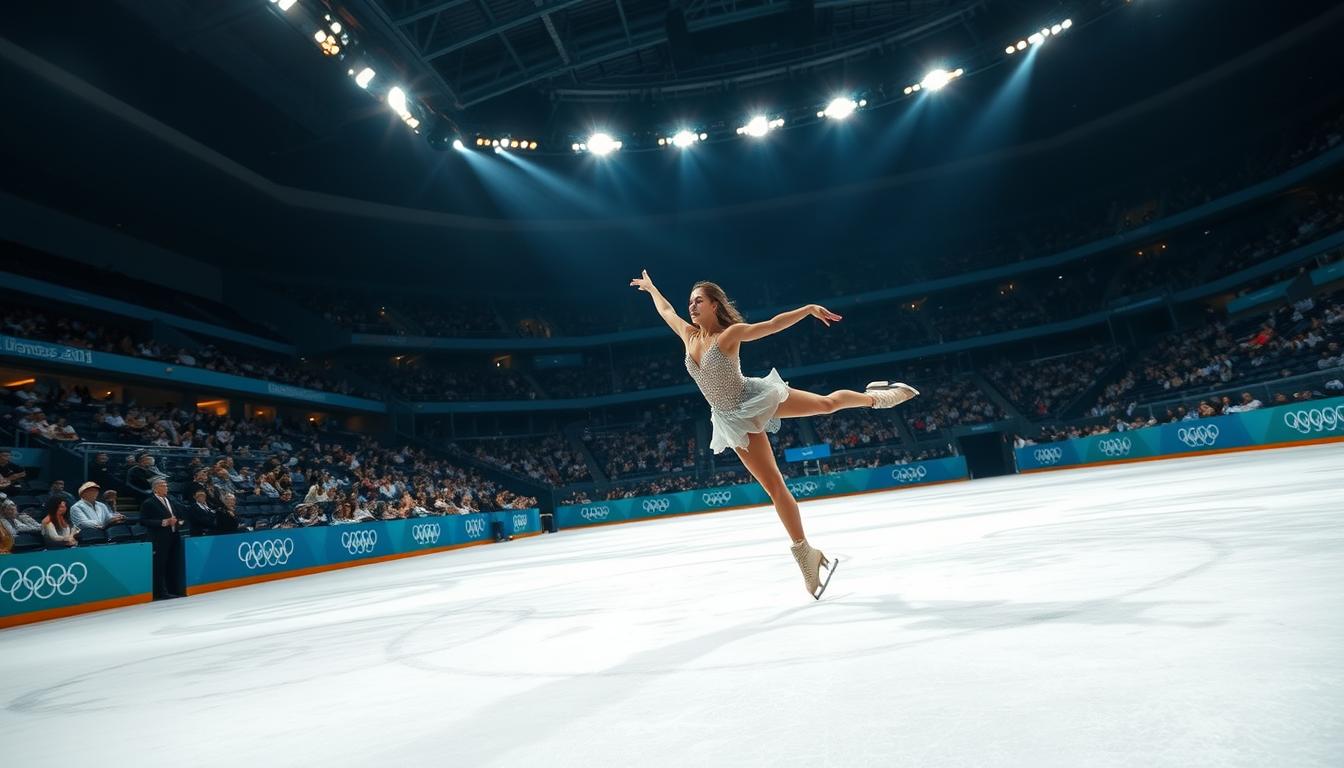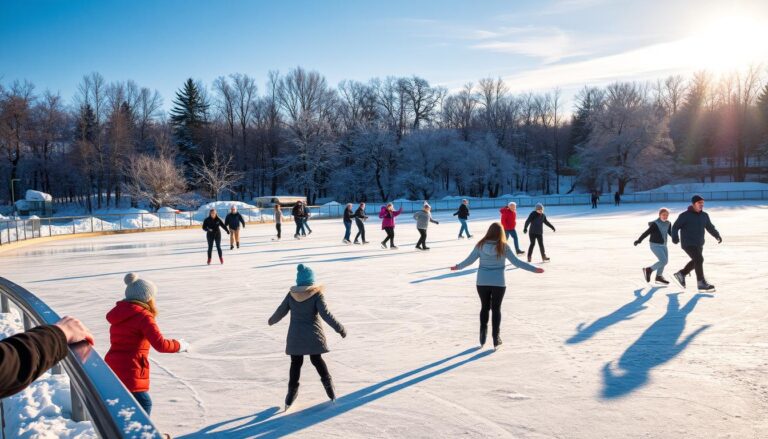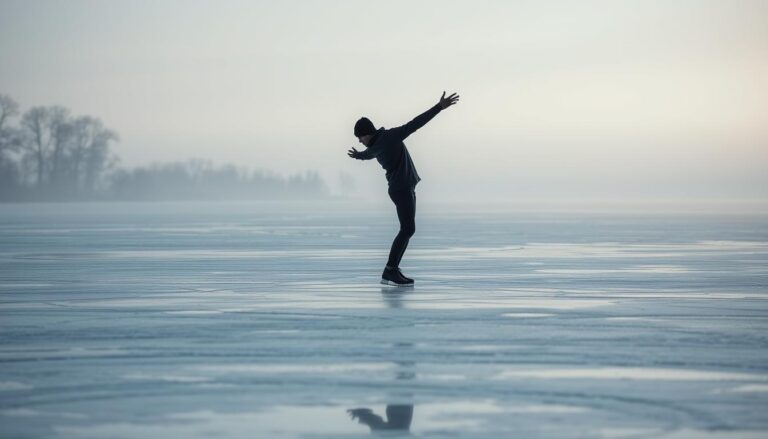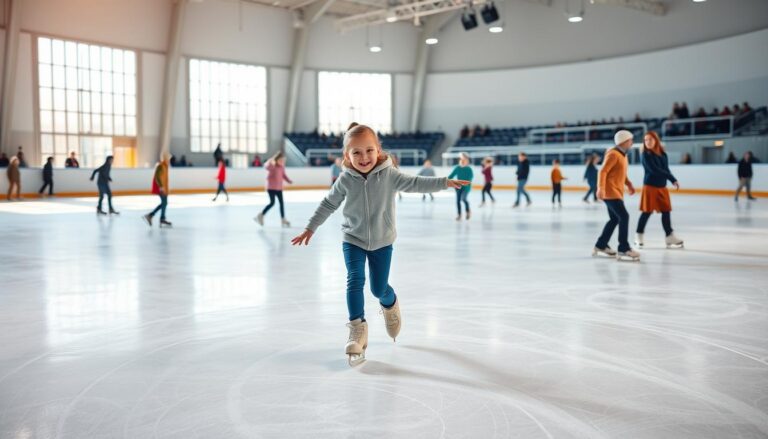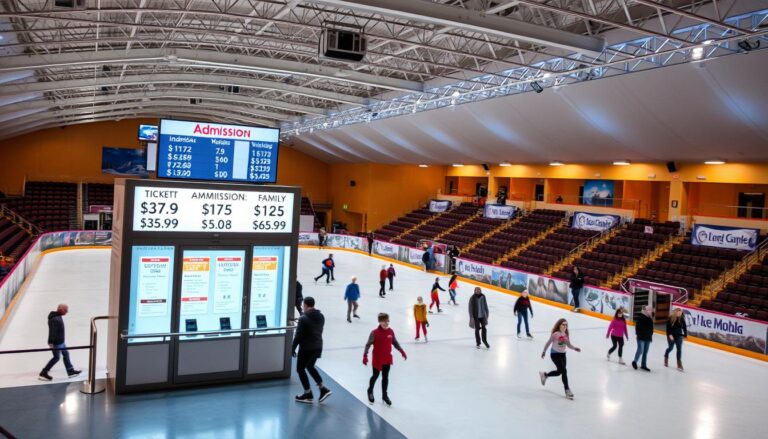Your Special Ideas For Ice Skating at the Olympics
Imagine the thrill when Olympic ice sports turn ordinary athletes into legends. Is ice skating in the Olympics just a competition? It’s a stunning mix of precision, power, and human talent that draws millions of fans.
Winter Olympics ice sports are the top of athletic achievement. Figure skating shows off graceful moves, while speed skating displays explosive power. These sports highlight the amazing abilities of athletes.
Olympic ice sports require incredible skill, years of hard work, and quick decisions. Athletes at this level are not just performers. They are artists, strategists, and athletes all in one.
The path to Olympic ice skating success is long and tough. Athletes spend thousands of hours training. They perfect their skills, turning them into world-class performers.
If you love sports or dream of becoming an athlete, learning about Olympic ice sports is fascinating. Each sport, from figure skating to speed skating, has its own story of hard work, passion, and the quest for perfection.
In this guide, we’ll dive into the amazing world of winter Olympics ice sports. We’ll look at the techniques, history, and amazing stories behind these incredible athletic feats. These stories inspire athletes and fans for generations.
The Evolution of Olympic Ice Skating Through History
Ice skating has changed from a simple winter activity to a global sports event. The winter games have seen big changes in skating, exciting millions around the world.
The start of competitive skating was on frozen European lakes. It began as a way to survive and grew into an art form. Athletes found that gliding on ice was not just useful—it was amazing.
Early Origins of Competitive Skating
Competitive skating started in the 13th century in the Netherlands. Skaters used bone skates to move on frozen canals. They developed skills that became the base of today’s winter sports.
- 13th century: First recorded competitive skating events in Europe
- 1850s: Introduction of steel-bladed skates
- 1876: First official skating championships in Vienna
Milestone Moments in Olympic Ice Sports
The Olympics changed skating competitions a lot. Key moments include the first figure skating event in the 1908 London Olympics. This made ice sports recognized worldwide as top athletic events.
Revolutionary Changes in Rules and Scoring
Skating competitions have seen big changes in judging and rules. New scoring systems made the games more fair and exciting. Athletes now face new challenges in both skill and art.
- 1990s: Implementation of detailed technical scoring
- 2004: Complete overhaul of judging criteria
- Current era: Emphasis on both technical precision and artistic interpretation
Olympic ice skating has grown from simple beginnings to a global event. It combines athletic skill with artistic talent, captivating everyone who watches.
Is Ice Skating in the Olympics: Understanding the Core Disciplines
Ice skating is a big deal in the Winter Olympics. It has many exciting disciplines that show off athletes’ amazing skills. These disciplines mix art, speed, and strength in a unique way.
The world of Olympic ice skating includes three main categories:
- Figure Skating: A mix of athletic jumps and artistic flair
- Speed Skating: All about speed and staying on the ice
- Ice Hockey: A team sport that’s all about strategy
Each discipline tests different skills. Figure skaters need both technical skill and creativity. Speed skaters focus on being fast and enduring. Ice hockey players work together and use strategy.
Olympic ice skating has changed a lot over time. Athletes train all year, using new tech and methods to get ahead. The Olympics give them a chance to show off their incredible abilities.
People all over the world watch these athletes compete. They celebrate the challenges and amazing performances that make Olympic ice skating so special.
Figure Skating: The Crown Jewel of Winter Olympics
The Winter Olympics shine brightly with figure skating. This sport mixes athleticism with art, drawing fans worldwide. It turns ice into a stage for human creativity.

Figure skating’s Olympic charm comes from three main areas. They show off incredible talent and creativity:
Singles Competition: Individual Mastery
Singles figure skating is a test of personal skill. Athletes do:
- Complex jumps with precise rotations
- Intricate spins showing great control
- Choreographed sequences telling emotional stories
Pairs Skating: Synchronized Perfection
Pairs skating takes figure skating to new heights with teamwork. Skaters do:
- Gravity-defying lifts
- Synchronized movements
- Artistic interpretations
Ice Dancing: Artistic Brilliance
Ice dancing turns figure skating into a ballet on ice. Competitors display:
- Intricate footwork
- Passionate storytelling through movement
- Musical interpretation that goes beyond sport
Olympic figure skating keeps pushing limits, winning hearts with its mix of athleticism and art.
Speed Skating: Racing for Olympic Glory
Olympic ice sports hit their highest point with speed skating. It’s a mix of power, precision, and quick thinking. Athletes move fast on the ice, showing off their amazing skills.
Speed skating has two main types that test athletes’ skills:
- Long Track Speed Skating: Racers race on a 400-meter oval, focusing on their own times.
- Short Track Speed Skating: It’s fast-paced, with many skaters racing together, needing strategy and quick moves.
New tech has changed speed skating. Modern skates use special materials to glide better and faster. Skaters wear suits that cut through air, making them even quicker.
To be an Olympic speed skater, you need to be in top shape. Athletes work hard to build:
- Strong legs
- Good heart health
- Sharp technical skills
- Strong mental toughness
The sport keeps getting better, with each Olympics bringing new records and amazing performances. These moments inspire fans all over the world.
Olympic Ice Hockey: Team Spirit on Ice
Ice hockey electrifies the winter games with its intense team dynamics and heart-pounding action. Athletes from around the world come together on the ice. They represent their nations with unmatched passion and skill.
The Olympic ice hockey tournament turns the rink into a battlefield. It’s a place of strategy, speed, and pure athletic prowess.
The winter games feature two remarkable tournaments that grab global attention:
- Men’s international ice hockey competition
- Women’s ice hockey championship
Men’s Tournament Structure
Olympic ice hockey for men has a tough tournament format. It tests the best teams globally. Nations qualify through intense international competitions, bringing together top-tier athletic talent.
| Tournament Stage | Team Count | Competition Format |
|---|---|---|
| Preliminary Round | 12 Teams | Group Stage Matches |
| Qualification Round | 8 Teams | Elimination Matches |
| Medal Rounds | 4 Teams | Semi-Finals and Finals |
Women’s Competition Growth
Women’s ice hockey has seen remarkable growth in the winter games. It debuted in the Olympics in 1998. The sport has grown in skill, visibility, and global participation.
Historic Olympic Hockey Moments
The Olympic ice hockey stage has seen legendary performances. These moments go beyond sport. They represent the pinnacle of athletic achievement and national pride.
- 1980 United States men’s unexpected victory
- Canada’s consecutive gold medal wins
- Breakthrough performances by women’s teams
Training Regimens of Olympic Ice Skaters
Olympic ice sports need athletes to give their all. Skating competitions take years of hard work. Skaters turn raw talent into top-notch performances through detailed training.
Top skaters stick to strict training plans. These plans include:
- On-ice technical skill development
- Strength and conditioning workouts
- Flexibility and mobility training
- Mental preparation techniques
- Nutrition and recovery strategies
Each Olympic ice sport has its own training style. Figure skaters work hard on art and complex moves. Speed skaters focus on quick power and long-lasting stamina. Hockey players mix skating skills with teamwork.
A week of training for Olympic skaters might look like this:
| Training Activity | Hours per Week |
|---|---|
| On-Ice Practice | 15-25 hours |
| Strength Training | 6-10 hours |
| Flexibility/Conditioning | 5-8 hours |
Skating pros know winning takes everything. They need mental strength, physical endurance, and skill. These athletes inspire fans all over the world.
Essential Equipment and Technology in Olympic Skating
Olympic skating has changed a lot thanks to new technology. Now, athletes use top-notch gear that helps them perform better. This includes everything from special skates to advanced materials.
Today’s skating gear is a mix of science and sports. Athletes need the right equipment to win. It’s what can make the difference between winning and coming in second.
Innovation in Skate Design
Skate design has seen big changes thanks to new tech. Some key improvements include:
- Carbon fiber blades for better strength
- Custom boots for a perfect fit
- Light materials to reduce tiredness
- Special blade shapes for better movement
Performance-Enhancing Gear
Skaters use advanced gear to improve their skills. They wear special clothes and use tools made for top performance:
| Gear Type | Performance Enhancement | Technology Used |
|---|---|---|
| Compression Suits | Muscle Support | Gradient Compression Fabric |
| Blade Holders | Precision Alignment | 3D-Printed Customization |
| Thermal Undergarments | Temperature Regulation | Moisture-Wicking Materials |
Ice Maintenance Technology
The quality of the ice is very important for skating. New tech helps keep the ice perfect for competitions. Precision ice preparation is key for top skating.
Ice techs use advanced tools to make and keep the ice just right. They watch the temperature, humidity, and smoothness very closely.
Scoring Systems and Judging Criteria
Learning about the scoring systems in skating competitions changes how you watch figure skating. The International Judging System (IJS) has changed how athletes are judged at the Olympics. It makes judging more clear and detailed.
In figure skating, judges use a complex scoring method. It breaks down performances into two key parts:
- Technical Elements Score (TES)
- Program Components Score (PCS)
The Technical Elements Score rewards skaters for their jumps, spins, and step sequences. Each element gets a base value. More points are added for exceptional quality. Precision is more important than ever in modern skating competitions.
Program Components Score looks at the artistic side of a performance. It includes:
- Skating Skills
- Transitions
- Performance
- Composition
- Interpretation of Music
Olympic figure skating now requires athletes to show both technical skill and artistic flair. Judges use a detailed point system. This system allows for a more nuanced evaluation, ensuring the most skilled athletes win.
The scoring system keeps getting better. It pushes athletes to create more complex and engaging routines. These routines show the true artistry of Olympic-level skating.
Famous Olympic Ice Skating Venues
The world of winter olympics and ice events turns ordinary arenas into magical stages. Olympic ice skating venues are more than just buildings. They are places where champions are made and history is written.

Each Olympic arena has its own legacy. They are designed to meet international standards. These spaces combine architecture and engineering to create the best environment for winter sports.
Iconic Winter Games Arenas
Several venues have become legendary in the world of winter olympics and ice events:
- Bolshoy Ice Dome (Sochi, Russia)
- Olympic Oval (Calgary, Canada)
- Gangneung Ice Arena (Pyeongchang, South Korea)
- Utah Olympic Oval (Salt Lake City, USA)
Facility Requirements and Standards
Olympic ice skating venues must meet strict requirements for fair competition:
| Requirement | Specification |
|---|---|
| Ice Surface Temperature | -4°C to -5°C (24.8°F to 23°F) |
| Rink Dimensions | 60m x 30m standard international size |
| Lighting | Minimum 1000 lux uniformity |
| Sound Insulation | Reduce external noise interference |
These remarkable venues inspire athletes and audiences. They make winter olympics unforgettable spectacles of human achievement.
Olympic Ice Skating Fashion Evolution
Figure skating has changed a lot in costume design. What started as simple, tight clothes has turned into a colorful way to show off skills and style.
In the early days, skaters wore heavy wool clothes that made it hard to move. But, designers soon saw how costumes could make performances better and tell stories.
- 1920s: Ankle-length skirts and structured jackets
- 1950s: Introduction of more flexible fabrics
- 1980s: Emergence of sequins and dramatic designs
- 2000s: High-tech, performance-enhancing materials
Today, figure skating costumes are all about showing off talent while following rules. There are strict rules about what costumes can look like and how much they can show.
| Decade | Costume Characteristics | Performance Impact |
|---|---|---|
| 1920-1950 | Structured, conservative designs | Limited movement |
| 1960-1980 | Emerging color and fabric variety | Increased artistic expression |
| 1990-Present | High-tech, form-fitting materials | Enhanced athletic performance |
Now, designers work with skaters to make costumes that fit the rules and show off their stories and skills.
Mental Preparation and Psychology in Ice Sports
Olympic ice sports need more than just physical skill. Skating competitions require mental strength. Athletes face intense emotions while performing at their best under global watch.
Competitive skaters use special mental strategies to do well under pressure. Mental training is as important as physical training in olympic ice sports.
Handling Olympic Pressure
Professional athletes use advanced mental techniques to handle stress:
- Visualization of successful performances
- Breathing control techniques
- Meditation and mindfulness practices
- Positive self-talk and affirmation strategies
Competition Mindset Training
Psychological preparation includes structured ways to build mental toughness:
| Training Method | Psychological Benefit |
|---|---|
| Cognitive Restructuring | Transforms negative thought patterns |
| Goal Setting | Creates clear performance objectives |
| Stress Management Workshops | Develops emotional regulation skills |
Mental strength is what sets great athletes apart from champions in skating competitions. Top athletes know that mental preparation is key to Olympic success.
International Rivalries and Notable Competitions
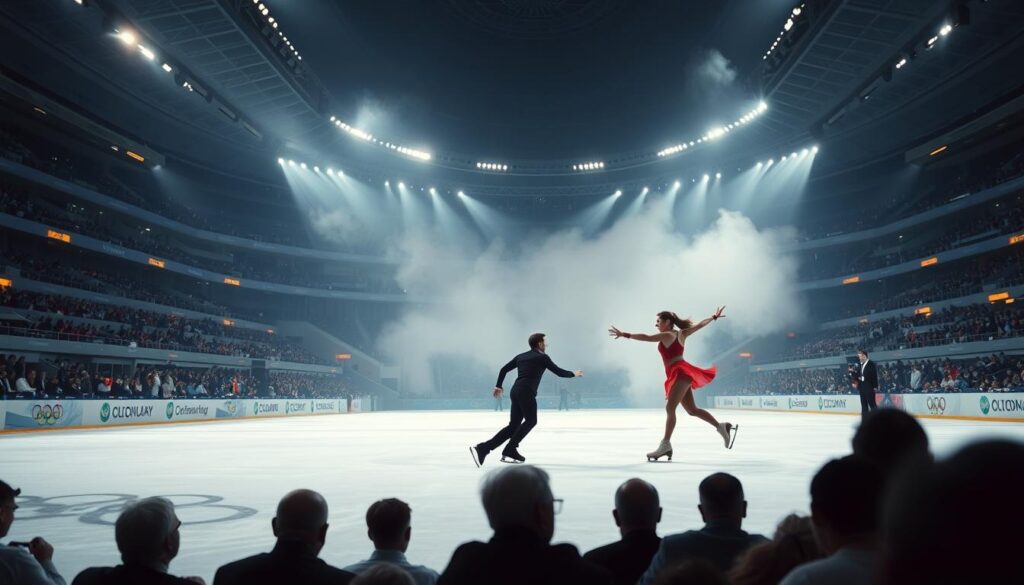
The winter olympics highlight intense rivalries in ice sports. Skating competitions turn arenas into battlefields. Here, national pride and athletic skill meet.
For decades, Olympic ice sports have been shaped by legendary rivalries. These matchups grab the world’s attention:
- Russia vs. United States in figure skating
- Netherlands vs. South Korea in speed skating
- Canada vs. United States in ice hockey
Each rivalry adds a special flavor to winter olympics. Athletes train for years to wear their country’s colors. They aim to break ice sports’ limits.
Some competitions have become iconic in Olympic ice sports history. The battles between skating legends go beyond sports. They tell stories of culture and nation.
International tournaments, like World Championships and Grand Prix events, are key. They help athletes grow and keep the competitive fire alive. These events are stepping stones to the Olympics.
The athletes’ passion, hard work, and competitive drive inspire millions. They turn ice sports into global spectacles of human achievement.
Olympic Ice Skating Records and Achievements
The winter games have seen incredible moments in ice skating. These moments show what humans can do on ice. Ice skating at the Olympics is a top level of skill and dedication.
Olympic ice skating records show how the sport has grown. Athletes have set new standards, showing what’s possible for humans.
Outstanding Individual Performances
Some athletes have made a big mark in Olympic ice skating:
- Yuzuru Hanyu from Japan won back-to-back gold medals in men’s figure skating
- Peggy Fleming changed women’s figure skating in the 1960s
- Katarina Witt was a top figure skater in the 1980s
Team Competition Milestones
Winter games have seen great team achievements:
- Russia’s strong pair skating
- Canada’s ice dancing excellence
- United States’ speed skating success
These achievements are more than medals. They show human ability, hard work, and the Olympic spirit.
Future of Olympic Ice Sports
The world of Olympic ice sports is changing fast. New tech and what athletes want are driving these changes. Soon, ice events will mix old traditions with new tech in exciting ways.
There are many new things coming to Olympic ice sports:
- Advanced tracking tech for athletes
- New ice sports with unique formats
- Virtual training and analysis tools
- Green ice event setups
Climate change is a big problem for winter sports. The Olympic groups are working hard to keep ice events alive. Artificial ice technologies and tough training places are key for future games.
New tech will change how athletes train and compete. Things like wearable sensors and AI coaching could change how we see sports.
The skating world is looking forward to big changes. Things like better equipment, more inclusive sports, and better fan experiences are coming. These changes will make ice sports even more exciting.
Athletes and fans have a lot to look forward to. The future of ice sports will be all about pushing limits and being green.
Health and Safety Considerations in Olympic Skating
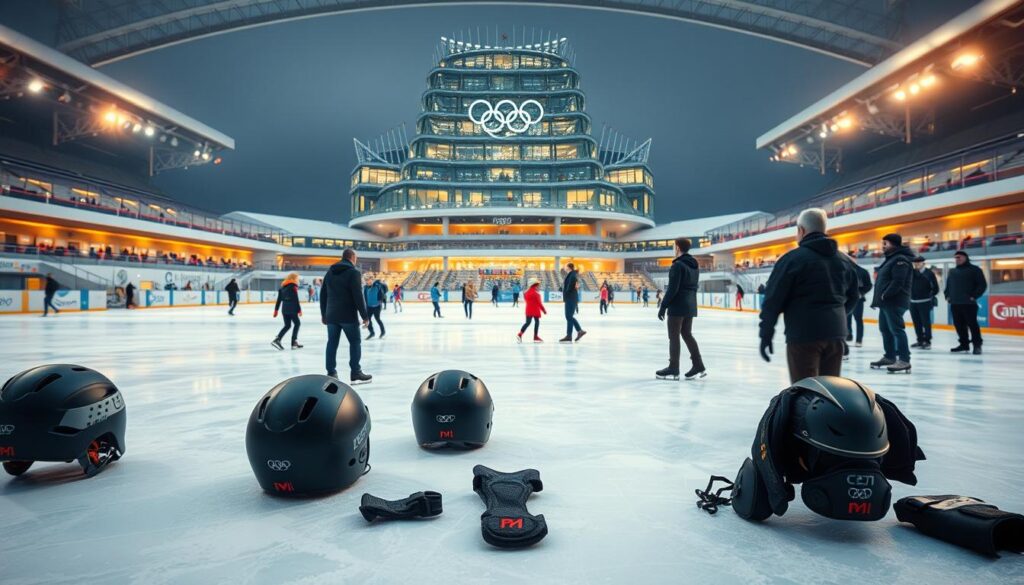
Olympic ice sports require incredible physical strength and strict safety measures. Athletes in these competitions face special challenges. They need thorough health protection plans to stay safe and perform well.
Safety in olympic ice sports involves many important parts:
- Advanced protective gear design
- Comprehensive medical support systems
- Preventive conditioning programs
- Real-time injury assessment techniques
Skating competitions use detailed safety plans. These plans cover physical and mental preparation. Cutting-edge sports medicine technologies help monitor athlete health and develop recovery plans.
Key safety considerations include:
- Regular medical evaluations
- Specialized equipment inspections
- Biomechanical movement analysis
- Mental health support services
Modern olympic ice sports focus on preventing injuries. Medical teams work with coaches to create safe training plans. These plans help athletes perform at their best while staying safe.
Conclusion
Ice skating in the Olympics is more than a sport. It’s a display of human talent, where athletes turn ice into a stage of art and skill. The Winter Olympics ice skating events capture the world’s attention, mixing technical skill with deep emotions.
Every Olympic season brings new stories of hard work, talent, and love for the sport. Figure skating shows off elegant moves, while speed skating is all about fast racing. These sports show the amazing abilities of humans. The Winter Olympics are where skaters from everywhere compete, break records, and inspire millions.
Watching Olympic ice skating is a special treat. It’s a mix of sport, art, and personal victory that crosses all borders. Whether you’re just watching or really into skating, the Olympics offer something magical.
Your exploration of Olympic ice skating doesn’t stop here. It should make you curious, motivate you to try sports, and make you appreciate this amazing sport more. Next time you watch, you’ll see the stories of hard work and dreams behind every move.
